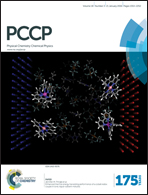Unraveling the ultrafast behavior of nile red interacting with aluminum and titanium co-doped MCM41 materials†
Abstract
We report on the spectroscopy and photodynamic characterization of Brønsted and Lewis acid sites within solids with respect to the behavior of Nile Red (NR) upon interaction with single- and multi-metal(X)-doped MCM41 materials (X = Ti and/or Al) in dichloromethane (DCM) suspensions. The steady-state results show that the H-bonding ability of doped MCM41-based materials leads to different NR populations (monomers, H- and J-aggregates), wherein their contributions are related to the type of acidic site (Brønsted or Lewis) and percent of acid sites (Si/X atomic ratio) in the silica framework. While at different Al doping contents the interacting NR populations suffer slight modifications, an increase in the Ti content induces a substantial increase in J-aggregate formation. Moreover, the picosecond time-resolved data not only confirm the H-bonding interactions between the X-MCM41 hosts and the different types of NR populations, but also indicate that the S1 deactivation pathways of these populations are connected to the Brønsted and Lewis acidities of the host. The shortening in the emission lifetimes of NR species is significantly associated with increased Lewis acidities (Ti doping). The femtosecond dynamics of loaded NR in single and multiple metal doped MCM41 show that the charge separation (CS) state (formed in ∼200–370 fs) and the subsequent electron injection (EI) process (∼200 fs) are sensitive to the content and type of acid sites. These observations are based on the time shortening of the CS state formation from ∼350 fs in the NR/Al-MCM41 samples (at 1% of Al) to <200 fs in the NR/Ti-MCM41 composites. For NR/Ti-Al-MCM41 sample, the observed change is directly related to the Ti content. At 1% of Ti the CS is formed in ∼300 fs, whereas at 3% of Ti it decreases to <200 fs. The same behavior is observed for the EI event, wherein its probability is related to the Ti content – higher doping results in a faster EI process (from ∼250 fs to ∼150 fs). Therefore, the interactions of these co-metal-doped MCM41 materials (Ti-Al-MCM41) with NR show competition between the Brønsted (Al doping) and Lewis (Ti doping) acid sites. Our findings may help to achieve a better understanding of the reactivity within metal-doped mesoporous catalysts and could be used in related fields such as drug delivery and nanophotonics using-silica materials.


 Please wait while we load your content...
Please wait while we load your content...